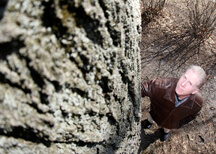

March 3, 2009
Danger lurks underground for oak seedlings
WEST LAFAYETTE, Ind. - |
Purdue University researcher Robert Swihart found that pine voles, small rodents that live underground, prefer oak roots to those of other commonly growing seedlings. The study identifies the rodents as a possible factor leading to high oak mortality rates that are threatening the resource base of the hardwood industry.
"You see a lot of mature oaks, but you don't see a lot of oaks in the understory beneath the canopy. If you don't see them there, you won't see mature oaks in 20 to 30 years," Swihart said. "We are facing a period in our history that could lead to a great crash in oak availability."
Swihart offered pine voles a selection of tree roots to eat in the laboratory, and they overwhelmingly gravitated toward oak roots. Voles caused more than twice as much damage to white oak roots than northern red oak and black cherry, and more than six times more damage to white oak than black walnuts. The voles snubbed yellow poplar roots altogether.
"Either the oak roots were much more nutritious and had higher energy content, or they contained fewer toxins, or some combination of those factors. Those are the main reasons an animal will choose one food item over another," Swihart said.
Swihart's study has been published in the current edition of the Canadian Journal of Zoology.
Under a variety of growing conditions, oak seedlings have comparatively high mortality rates, allowing other trees such as shade-tolerant maples and sun-loving, fast-growing tulip poplars to make up larger percentages of hardwood forests. Most of the studies on why oaks have a hard time regenerating have focused on competition from other seedlings, the use of acorns as food for small animals above the ground and the use of oak seedlings as food for deer.
"A lot of the focus has been on what's occurring above ground. We decided to look at what's going on below the ground," Swihart said. "We know pine voles can do a lot of damage in apple orchards, but there is little, except for a few anecdotal accounts, of what they do in their natural environment."
Swihart got the idea for his study from Ron Rathfon, a Purdue Extension forestry specialist in southern Indiana who has studied oak mortality issues. Rathfon found in 2006 that animals, later determined to be pine voles, had been responsible for killing at least 19 percent of the dead oak seedlings observed in his study area. He said the voles, which are common to eastern deciduous forests, were likely responsible for the majority of oak seedling mortality because many seedlings went missing, suggesting the voles had eaten or removed the entire plants.
There is little overall loss of oak forest to date, but Rathfon said that might change if foresters, the timber industry and landowners do not implement practices that better manage long-term oak growth and development.
"We do see some data that more shade-tolerant trees - particularly sugar maples - are becoming more prominent," Rathfon said. "It is a gradual, subtle shift that is taking place."
Swihart said the loss of oaks would have other serious effects besides losses to the hardwood industry.
"Oak mortality could reduce the capacity of hardwood forests to support wildlife populations that rely on oaks for food - everything from deer and turkey down to mice and songbirds," Swihart said.
Purdue undergraduate student Leslie Schreiber worked with Swihart on the pine vole study. Funding for the work came from Purdue Agriculture.
Writer: Brian Wallheimer, (765) 496-2050, bwallhei@purdue.edu
Sources: Robert Swihart, (765) 494-3590, rswihart@purdue.edu
Ron Rathfon, (812) 678-5049, ronr@purdue.edu
Ag Communications: (765) 494-2722;
Beth Forbes, forbes@purdue.edu
Agriculture News Page
PHOTO CAPTION:
Robert Swihart, professor of forestry and natural resources, found that pine voles, when given a choice, prefer to eat oak roots. Swihart believes voles are part of the reason oak trees are having difficulty regenerating in forests. (Purdue Agricultural Communication photo/Tom Campbell)
A publication-quality photo is available at https://www.purdue.edu/uns/images/+2009/pine-voles.jpg
Selective Feeding of Pine Voles
on Roots of Tree Seedlings
Leslie Schreiber and Robert K. Swihart
Previous studies have implicated numerous physical and biotic factors as contributing to the failure of oak to regenerate successfully throughout substantial portions of eastern North America. Recent field evidence in southern Indiana implicated below-ground herbivory by pine voles, Microtus pinetorum (LeConte, 1830), as a potentially important but overlooked mortality agent for oak seedlings. We used cafeteria-style feeding trials to determine whether selection of hardwood seedlings by captive pine voles differed according to species or age. White oak (Quercus alba L.) was selected more frequently and experienced a greater proportion of root removal by pine voles than same-age seedlings of the other four species tested. Yellow poplar (Liriodendron tulipifera L.) was never eaten. White oak seedlings 3 and 6 weeks of age suffered proportionately greater root removal than conspecific seedlings 12 and 15 weeks of age; pine voles removed roughly constant levels of root biomass irrespective of seedling age. Our results confirm that pine voles selectively feed on oak seedlings. In areas where pine voles are abundant, below-ground herbivory could limit regeneration of oak by reducing seedling growth and survival. The importance of pine voles as factors influencing the success of oak regeneration warrants closer scrutiny in future field studies.
To the News Service home page
